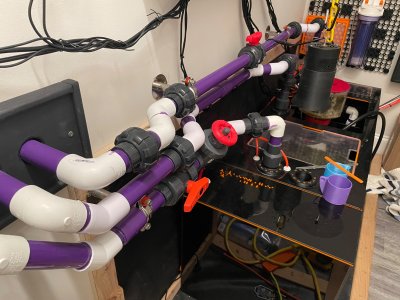Reply with what kind of hard or soft plumbing you use. Interested to see people's opinions on this.
You are using an out of date browser. It may not display this or other websites correctly.
You should upgrade or use an alternative browser.
You should upgrade or use an alternative browser.
Soft plumbing vs hard plumbing
- Thread starter BristleWormHater
- Start date
I use 1" vinyl pipes on my main display and 1/3" vinyl on my frogfish tank. I've never really needed to do much complex plumbing or anything, but I expect that adding new lines is easier with soft plumbing as well.
Schedule 80 PVC mostly because it looks pretty. I like blue pipes + grey fittings. It does have the practical advantage of being cat proof. Soft tubing is more susceptible to getting dislodged, kinked, or punctured by a rowdy feline (or a clumsy ADHD human...)
Schedule 80 on my main drain line, soft plumbing on the emergency drain and the return:
I got into reefing at the beginning of 2012. Started with a 5.5g bowfront that we had been using as a hermit crab enclosure, quickly moved to an 11.4g Mr Aqua, then to a full 90g. Eventually broke that down because of the work involved and ended up with a 30g shallow from Deep Blue. I also had some kind of small AIO by my desk at one point.
I ended up having an issue with the 30g that started killing off everything in it. I never did figure out what it was, and with all the work and stress of the past several years, I decided to take a break for a while. I almost got back in at...
I ended up having an issue with the 30g that started killing off everything in it. I never did figure out what it was, and with all the work and stress of the past several years, I decided to take a break for a while. I almost got back in at...
- shanepike
- Replies: 6
- Forum: Mid-Sized Tanks
I voted hard plump, although I use a 16" length of 1" ID silicone tube to go from the return pump to the manifold that feeds my system. The silicone tube lessens the vibrations in the plumbing and also makes it easier to remove and clean the return pump. Silicone stays flexible unlike the vinyl tubing that gets stiff over time.
I hard plumb everything. I'm not color coordinated and don't have a preference, so I use schedule 40 most everywhere and flex PVC where I can to cut down the number of 90's and 45's. The only places I use schedule 80 is in bulkheads, gate valves, true union ball valves, and sometimes in unions.
No pump we have in this hobby is going to build enough pressure that schedule 80 is needed. Like not even close. The only reason for schedule 80 is purely ascetics. And for many, like PC builders, the sump and plumbing are an integral part of the overall look of the system.
No pump we have in this hobby is going to build enough pressure that schedule 80 is needed. Like not even close. The only reason for schedule 80 is purely ascetics. And for many, like PC builders, the sump and plumbing are an integral part of the overall look of the system.
From my limited experience, hard plumbing seems to be the favorite, especially in larger systems, both for structural rigidity as well as aesthetics.
My last reef was all soft plumbing, but we had only two lines, from the overflow to the sump, and the return.
My current is an AIO, so no plumbing required, per se, however I was expecting I would wind up using soft plumbing to connect up my 'fuge, which I'm intending to have sit on a shelf above the tank. I think hard plumbing here would make it a bit of a maintenance nightmare, should I ever need to move anything, or do any kind of extensive maintenance. Hard plumbing would definitely be more attractive and professional-looking, long term Perhaps I should consider doing hard plumbing for 90% of it, and a little soft plumbing at the ends just to keep the bits that run into/out-of the tank a little easier to work with and manage.
Perhaps I should consider doing hard plumbing for 90% of it, and a little soft plumbing at the ends just to keep the bits that run into/out-of the tank a little easier to work with and manage.
After 29 years in I.T., and having run literally hundred of miles (or more) of cabling, I am quite a sucker for "cable-porn" (reddit link - safe-for-work), so plumbing shouldn't be much different, I guess.
My last reef was all soft plumbing, but we had only two lines, from the overflow to the sump, and the return.
My current is an AIO, so no plumbing required, per se, however I was expecting I would wind up using soft plumbing to connect up my 'fuge, which I'm intending to have sit on a shelf above the tank. I think hard plumbing here would make it a bit of a maintenance nightmare, should I ever need to move anything, or do any kind of extensive maintenance. Hard plumbing would definitely be more attractive and professional-looking, long term
After 29 years in I.T., and having run literally hundred of miles (or more) of cabling, I am quite a sucker for "cable-porn" (reddit link - safe-for-work), so plumbing shouldn't be much different, I guess.
- Messages
- 810
- Reaction score
- 857
Flex - easy and flexible to change. But kinda ugly
Hard- requires a lot of planning for manifolds and double measuring to get everything right. Looks janky if rushed and even worse if using standing piping. Nice colored pipe done right is very clean
If your into computers, water cooling is one one the same. Flex is easy, hard plumping is more aesthetically pleasing. Lot different money as well
Hard- requires a lot of planning for manifolds and double measuring to get everything right. Looks janky if rushed and even worse if using standing piping. Nice colored pipe done right is very clean
If your into computers, water cooling is one one the same. Flex is easy, hard plumping is more aesthetically pleasing. Lot different money as well
All of the soft plumbing I installed over the years on my tank slowly turned into hard plumbing for the looks. I still like to put a system together with fitting and flex vinyl but that's only to get a feel for how I want things. I've always been one to rearrange and change things around in my sumps once thing get set up and running. As I get "dug in" with the whole system, I move to hard plumbing with lots and lots and lots of Unions. Unions are a big expense when hard plumbing but so, so very worth it when something goes wrong.
Hard plumb with twice as many unions as you think you need.
How so? I assume to make things easier for maintenance or expansion/modification?Hard plumb with twice as many unions as you think you need.
How so? I assume to make things easier for maintenance or expansion/modification?
Yes to all of that. Also, when you are trying to fit angles, it’s significantly easier to dry fit when you can move/twist things a bit. One other thing, you’ll likely want to throw a gate valve on the drain so you can dial in the water level in the tank. It’s worth spending the extra money on a gate versus ball valve. Over time ball valves have a tendency to seize up, so if you are going to add them, don’t get the cheap box store ones.
Last edited:
Yes to all of that. Also, when you are trying to fit angles, it’s significantly easier to dry fit when you can move/twist things a bit. One other thing, you’ll likely want to throw a gate valve on the drain so you can dial in the water level in the tank. It’s worth spending the extra money on a gate versus ball valve. Over time ball valves have a tendency to seize up.
Attachments
I use mostly push to connect fittings on 1" PVC and a few parts that are pvc glue connected together. They seem to work quite well for me and are easy to adjust move around as things change or something goes wrong.
Push to fit connections are fine for the pressures involved, and they have a rubber gasket to prevent leaks. Despite about 50 connections in my 7 tank system, I have only had one temporary and slow leak over about 5 years.
Push to fit connections are fine for the pressures involved, and they have a rubber gasket to prevent leaks. Despite about 50 connections in my 7 tank system, I have only had one temporary and slow leak over about 5 years.
This is why we use unions! I noticed my emergency drain was making a ton of noise and went exploring. My wife mentioned she saw a snail hanging around the overflow earlier, but didn’t think he was dumb enough to go in. Whelp, snails are dumb! He went in, and got stuck in the gate valve. It took less than two minutes to kill the pump, close the ball valve from the tank, and take the gate out. The snail immediately fell out and I put it back together. No mess, no fuss!
Attachments
That's what I have too. Hard plumbing except line from pump to manifold. or Pump to UV loop.I voted hard plump, although I use a 16" length of 1" ID silicone tube to go from the return pump to the manifold that feeds my system. The silicone tube lessens the vibrations in the plumbing and also makes it easier to remove and clean the return pump. Silicone stays flexible unlike the vinyl tubing that gets stiff over time.
Similar threads
- Replies
- 2
- Views
- 455
- Replies
- 3
- Views
- 721
- Replies
- 0
- Views
- 292


